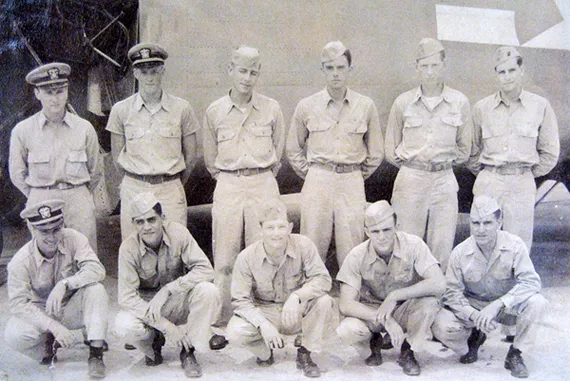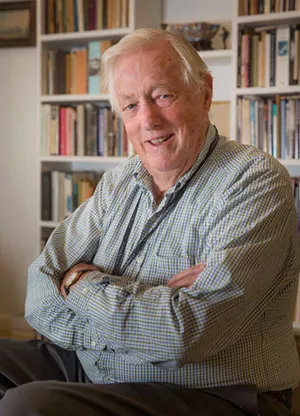Former Swarthmore Vice President Ken Landis '48 Reflects on College During Wartime

Ken Landis '48 (standing, second from left) interrupted his studies to enlist in the Navy during WWII and came back a changed man - to a changed campus.
In his senior profile in the 1948 Halcyon, Kendall “Ken” Landis '48 is colorfully referred to by his classmates as "a man with serious side and deep convictions," "the gift to complete liberation," and simply "the Landis Legend."
That is lofty acclaim, but befitting of a man still regarded by those who know him best as one of the College’s elder statesman. But the descriptions of Landis as a senior are a far cry from the person who set foot on campus in the fall of 1942.
“I was an immature 17-year-old when I first arrived at Swarthmore,” says Landis, who recently reflected on his undergraduate days on a crisp fall morning from his porch at the nearby Plush Mills community.
Approaching his 90th birthday, Landis has a long history with the College. After a career in banking that saw him spend nearly two decades in the Middle East, he returned to his alma mater to serve as the College’s vice president for development and alumni affairs in 1971, a position he held for 19 years before retiring. Additionally, two of Landis’ three children, Josh '79 and Ethan '84, also attended the College.
Despite his lifelong relationship with the College, his arrival at Swarthmore was anything but smooth. Along with his admitted immaturity, he was “a straight-C student” who was in danger of losing his scholarship. He also claims to have only learned “how to drink, and something about women” during that freshman year.
Landis would grow up in a hurry, as did many of the men of his generation, with the escalation of World War II. He was one of the hundreds of Swarthmore students from 1941 to 1945 whose undergraduate education was interrupted by the war. More about Swarthmore College during WWII

On his 18th birthday in November 1942 during his freshman year, Landis, like many others, enlisted in the military. While several classmates became conscientious objectors, Landis joined the Navy’s V-5 training program at the University of Pennsylvania, which prepared undergraduate students to fly in the Naval Air Corps. The program was related to the V-5 and V-12 undergraduate training programs housed at Swarthmore from 1943 to 1945, which brought nearly 1,000 naval cadets and potential deck officers to campus during the war years, outnumbering civilian men by almost two to one.
After finishing his freshman year at the College, Landis spent the next 23 months in training, learning how to fly in training facilities across the nation, including in North Carolina, Indiana, and Florida.
After months of grueling training which he recalls in vivid detail, Landis was set for deployment in the summer of 1945. From his home in Vermont, he ventured on a week-long cross-country train ride to San Diego, where he and his squadron would depart for the fight in the Pacific. He arrived in San Diego on August 16, 1945 – one day after the Japanese surrendered to end the war.
“There was relief, but of course it also was quite a letdown,” says Landis about the end of conflict after so many months of training. In retrospect, he is grateful for his fortunate timing, as his squadron was scheduled to provide air support for a slow-moving Jeep carrier, which he claims would have been a “sitting duck” for Japanese kamikaze pilots.
Landis was officially discharged from the Naval Air Corps on Nov. 13, 1945 – his 21st birthday – and it was time to return to college. Only for Landis, a changed man after two-and-a-half years of service, Swarthmore wasn’t exactly his desired location.
“The day after I was discharged, I traveled to New York City and applied to Columbia,” he says. “After my time away, I wanted to live in a big city.”
Unfortunately for Landis (and fortunately for Swarthmore), he was told by Columbia that because of his poor grades as a freshman, he would need to wait until February to find out if he even stood a chance at admission.
The next day, on a visit to Swarthmore to meet with old friends, a chance encounter with Dean of Admissions Everett Hunt reversed his fortunes.
“I was walking up Magill Walk and I ran into Dean Hunt. He asked me what was I going to do now that the war was over. I told him that I wanted to go to Columbia, but was on a waiting list,” Landis says. “He told me I could start at Swarthmore tomorrow. That was all that I needed to hear.”
Landis changed course and returned to Swarthmore immediately. Due to the housing crunch caused by the massive influx of undergrads returning to campus, he was forced to live in the nearby home of the College’s treasurer during his first semester back at school. With the campus size ballooning to over 1,110 students in the years following the war, the experience was not uncommon.
“My only responsibility to was to cut the grass,” Landis says with a laugh.
Like many of the men returning to the College following the war, Landis was a changed man following his wartime experiences. Admittedly more mature, he took a serious and enthusiastic approach to his studies. Landis spent a semester of his junior year in France and delved deep into the language and his history coursework. His grades improved dramatically and he eventually graduated with high honors in 1948.
“When we came back to campus, all of us had the feeling that we had lost time,” he says about the attitude of his fellow veterans.
Landis notes another unique aspect of the veterans’ mass return to campus – the close bonds developed between veteran students and faculty members. Landis notes that some of his closest friends at Swarthmore were faculty members, including Professor of Political Science Roland Pennock '29, Professors of History Paul Beik and Larry LaFore, Professor of English Sam Hynes, and Professor of English Phil Hicks '05, who had served as a naval aviator during World War I.
“Talking with professors in those days who had taught Swarthmore before and after the war, they refer to the postwar years as halcyon days," Landis says. "The students were evenly divided – half were vets and half were not. Reflecting this mix, classes were particularly interesting.”
Today, Landis stays active with Orchestra 2001 and the College's Scott Arboretum. Although he may not be seen on the Faulkner Tennis Courts as much he would like, he remains a presence in the Swarthmore community, attending lectures, concerts, poetry readings, and most recently marching (with his walker) with the Class of 1948 in the alumni parade at the College’s All-Alumni Weekend.



